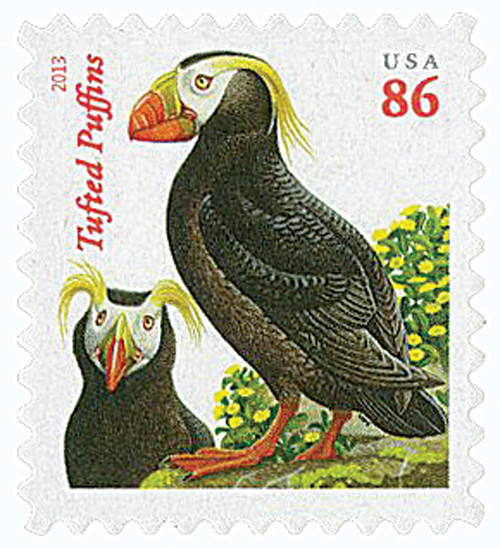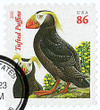
# 4737 - 2013 86c Tufted Puffins
U.S. # 4737
2013 86¢ Tufted Puffins
The Pacific Ocean gets an extra pop of color and character at the beginning of summer, as the tufted puffins approach their breeding season.
Named after their bright plumage (feathers), both male and female tufted puffins develop bright yellow tufts around their faces. Along with this change, their feet become bright red and their faces bright white. During the winter feeding season, the puffins’ tufts fall off and the bright coloring of the summer fades.
Although they spend their winters at sea, tufted puffins return to their birth colonies to breed with the same mates as the previous year. They find their way by a combination of sounds, smells, and visual cues.
Short wings and strong chest muscles allow tufted puffins to swim fast for long amounts of time in search of fish. When collecting food for their young, the puffins carefully arrange up to 20 fish in their bills to bring back to the nest.
Tufted puffins have strong nails that help them climb rocky cliffs and dig the burrows in which they live. Pairs create their nests by burrowing holes in the ground or in rock crevices – from two to seven feet deep.
Throughout their range along the Pacific Coast, tufted puffins build nests in colonies on islands or cliffs, away from predators. These colonies vary in number from just a few to over one million nests.
Robert Giusti of Connecticut created the Tufted Puffins artwork for this stamp. Born in Switzerland and raised in New York City, Giusti has had a life-long interest in wildlife. This interest is reflected in his numerous U.S. stamp designs that include the 2014 songbirds, 2012 Birds of Prey, 1999 Red Fox, 1998 Tropical Birds, 1992 Wild Animals, and 1991 Cardinal.
Value: 86¢ 3-ounce first-class letter rate
Issued: January 23, 2013
First Day City: Seward, AK – Alaska Sea Life Center
Type of Stamp: Definitive
Printed by: Ashton Potter
Method: Photogravure printing in sheets of 120, with 6 panes of 20
Perforation: Serpentine Die Cut 11 ¼ x 10 ¾
Self-Adhesive
Quantity Printed: 30,000,000 stamps
The Tufted Puffin stamps were printed a second time in 2013. Slight variations resulting from this second printing (dots in the “Tufted Puffins” inscription and “86” denomination) classified it as a major variety – U.S. #4737A.
U.S. # 4737
2013 86¢ Tufted Puffins
The Pacific Ocean gets an extra pop of color and character at the beginning of summer, as the tufted puffins approach their breeding season.
Named after their bright plumage (feathers), both male and female tufted puffins develop bright yellow tufts around their faces. Along with this change, their feet become bright red and their faces bright white. During the winter feeding season, the puffins’ tufts fall off and the bright coloring of the summer fades.
Although they spend their winters at sea, tufted puffins return to their birth colonies to breed with the same mates as the previous year. They find their way by a combination of sounds, smells, and visual cues.
Short wings and strong chest muscles allow tufted puffins to swim fast for long amounts of time in search of fish. When collecting food for their young, the puffins carefully arrange up to 20 fish in their bills to bring back to the nest.
Tufted puffins have strong nails that help them climb rocky cliffs and dig the burrows in which they live. Pairs create their nests by burrowing holes in the ground or in rock crevices – from two to seven feet deep.
Throughout their range along the Pacific Coast, tufted puffins build nests in colonies on islands or cliffs, away from predators. These colonies vary in number from just a few to over one million nests.
Robert Giusti of Connecticut created the Tufted Puffins artwork for this stamp. Born in Switzerland and raised in New York City, Giusti has had a life-long interest in wildlife. This interest is reflected in his numerous U.S. stamp designs that include the 2014 songbirds, 2012 Birds of Prey, 1999 Red Fox, 1998 Tropical Birds, 1992 Wild Animals, and 1991 Cardinal.
Value: 86¢ 3-ounce first-class letter rate
Issued: January 23, 2013
First Day City: Seward, AK – Alaska Sea Life Center
Type of Stamp: Definitive
Printed by: Ashton Potter
Method: Photogravure printing in sheets of 120, with 6 panes of 20
Perforation: Serpentine Die Cut 11 ¼ x 10 ¾
Self-Adhesive
Quantity Printed: 30,000,000 stamps
The Tufted Puffin stamps were printed a second time in 2013. Slight variations resulting from this second printing (dots in the “Tufted Puffins” inscription and “86” denomination) classified it as a major variety – U.S. #4737A.












